Unic In lume









Galgau Almasului, Judetul Salaj
Zmeilor garden is a particularly spectacular natural phenomenon, unique in Europe, considered by specialists. Reservation contained in an old tourist guide as “Garden Zmeilor. Locals call it “Girl Catanii. Is situated in Mount Meses, massive forming part of the Western Carpathians, near the town gurgling Almas, county Salaj.Reprezinta a geological reserve consists of many huge rocks, placed in a high clutter (buildings, towers, poles, mushrooms , rocks and animal forms). Spectacular forms of these formations can be explained by sliding layers of conglomerates and sandstones. Water had a significant role in shaping these rocks.Due to landslides natural forms of these elements may change from year to year. Most impressive are two prismatic rocks suggestively named “Zmeu” and “Zmeoaica. Other stone blocks were suggestively named “Santa”, “Eve” and “Dorobantu. Formations here were born by separation of blocks or sections of the massive sandstones are Inchieturi hill (376 m) and slip clays their purple at the base, to wire back hair. Subsequently, erosion and wind and rain denudatie, formed the most bizarre columns, buttresses, bridges, mushrooms, etc..some with heights of over 10-12 m (Suraru, 1967). Overall, they form a cluster chaotic strange that in every point where we look at other images depict the other, the most strange and surprising. “Garden Zmeilor” occupies an area of five hectares, the first formations to the slope. About Garden Zmeilor there is a rock legend called “Catanii girl” who turned into stone sheepfold to curse his mother. A column of the formations look like a virgin with a cofita the shoulder. Currently, “Girl Catanii” no longer exists. It collapsed in the floods of 1973.Rock looks like a girl who was a soldier from her and seemed to have a basket on his shoulder. Is a particularly spectacular natural phenomenon and is situated in Mount Meses, massive forming part of the Western Carpathians. It is located near the town of Salaj Almas gurgling. Here can be reached by train halt until the line pa lime Dej – Jibou – Baia Mare, then another 4 km to the south.
The Living Fires of Lopătari, Buzău are among the most mysterious, and unusual, phenomena you may find in nature, on a hiking path, within your reach. That’s if you know where to look. Romania was blessed with a few such miracles, places that could become its landmark tourist attractions, yet few is known about them. Today, we’ll take a look at one of those attractions, that, at the time I left Romania, was neglected by the authorities, and was known only by locals and a few enthusiastic mountaineers. Things have changed in the past ten years, with news of a future Geo-park “Land of Buzău” emerging in the media, but the development may take years to complete.

56 km from the city of Buzău, the county seat of Buzău County in the historical region of Wallachia, you’ll find the commune Lopătari. In one of the villages of this commune, Terca, there are the Living Fires (in Romanian: Focurile Vii) – a natural phenomenon, unique in Europe, but not unique to Romania. You’ll find a similar one, considered even more spectacular by some travelers, at Andreiaşu, a commune in Vrancea County, in the historical region of Moldovia, north of Buzău; and one in Reghiu commune, Vrancea, in the village of Răiuţi – only 8.5 km north of Andreiaşu.

Although the Living Fires of Andreiaşu (image above) occupy the most extensive area (400 m²), the Living Fires of Buzău are more popular with tourists, as they are situated close to other interesting natural attractions in the county, including: the Muddy volcanoes, the amber from Colti, the Salt from Meledic, the petroleum springs, salty springs, and so on.
 This is a closeup of the freely burning natural gas at Terca, Lopătari. On the fire, you can even cook a meal. Image courtesy, Wikipedia Romania.
This is a closeup of the freely burning natural gas at Terca, Lopătari. On the fire, you can even cook a meal. Image courtesy, Wikipedia Romania.The natural emanations of gas are lit at the surface, under the rays of the sun. The fires burn at night as well, when the scenery is at its most spectacular display. At times you can see a flame rising up to 1 m into the wind above the ground.
If their story has triggered your interest, then take a trip to Terca. In the summer, make sure you have enough water with you, the weather in Romania tends to get very hot, and the area around the Living Fires was not developed for tourist purposes. To understand, this is one of the signs marking the way to the Fires:
 A handmade sign marking the way to the Living Fires of Terca (probably by a villager, or mountaineer).
A handmade sign marking the way to the Living Fires of Terca (probably by a villager, or mountaineer).To reach the place, drive through the city of Buzău, on the route Mărăcineni–Sapoca-Manzalesti-Lopătari-Terca (the GPS coordinates are N 45.53578 E 26.54857). If you drive through Berca, it’s better to use a four-wheel-drive vehicle. In fact, it’s good to have a good car to drive from Lopătari to Terca anyway. Prepare for a hike as well: the car cannot take you to the Fires. You have to cross a handmade wooden bridge, that looks ancient and wobbly. Then the road takes you on uneven terrain up the hill, on a hike that, although not difficult, it could be pure torture after the rain (mud and all). Below, the terrain map of the area.
The only papyrus from Romania, discovered 53 (1959 I mean) years ago is written in old Greek. It is unique because it is whole. It dates from IV Century before Jesus. The place ? The Mangalia Resort , Statiunea balneo-climaterica Mangalia . It was transported in the Russian State of the UdSSR, in the same year for restauration and conservation . But in the summer of 2011 it was returned to the officials of The Archaeological Museum of Mangalia , Muzeul de Arheologie Callatis din Mangalia.
Callatis – the story of a city
Whether called Cerbatis or Acervatis, Callatis Pangalia, Mankalia or Mangalia, geographical position of this place always sat in the middle of history. He became the oldest known settlement in the country, while the scene of political, economic social and very important, which generated over time change of identity, without affecting the essence of place: a bit of brilliance Greek, a littlethe joy of glory, a bit of spiritual strength and a touch of deep Turkish Romanian wisdom associated with a sense of introspection. A unique rainbow sky Balkans, where each color is well individualized, but inseparable, in fact.
Callatis – the most beautiful
First settled here were Thracians, founding the settlement known as Acervatis or Cerbatis. Thracian settlements in the former, the Greeks landed here will build the city which would remain in history as the Callatis, famous for its material and spiritual prosperity, but also for famous scholars whom he sheltered from its walls.
The late fourth century BC Inteimeiata, by the people Heracleea Pontic, located on the Asian side of the Black Sea, the city was named in memory of Calesa river that surrounds land Heracleea metropolis. Predicting an oracle was the one who was in the building Callatis, the city that would become in a short time, one of the strongest in the area, but at the same time, and one of the richest.
Advantageous geographical position immediately convinced of the desirability of building on Greek settlement in this place: locked and access to a freshwater lake (now Lake Mangalia), fertile land, an advantageous military position, however confirm the vision oracle, who guided the Greeks to the ground. Unlike the other two cities, Tomis and Histria Milesian colony, mainly commercial and democratic, was the only colony Callatis Doriana, practicing agriculture and a leading oligarchic rather than democratic, where power was held only a few families. Even so, Callatis the saw in a very short time success. Cereals and maritime trade were two of the sources that provided the city a wellspring of wealth.
A situation could not have flourished as not to attract neighbors envy.Throughout its history, the city was placed numerous times in the face of strong sieges. But who was to submit its Pontic allies with Macedonian domination, lasted five years, from 313 until 308 BC They became free from the death of King Lysimachus conqueror, in 281 BC A long siege was not so as not to put their mark on the settlement, but again, the city was rebuilt quickly, quickly going through the steps of material wealth and cultural.
Around 262 i.e.n. Tomis Fortress began. Frightened by the idea of competition, the locals tried sabotaging construction, but experienced a resounding defeat of the Byzantine war fleet, came to help tomitanilor. Just like Phoenix, the city has returned shortly, keeping the head still for a while in the cities located on the shores of Black Sea, Pontus.
Romanian period that followed brought more prosperity to the city, now occupying the second position, after Tomis. Under the reign of Emperor Diocletian (284-305 AD) Constantine the Great (306-337 AD), then under Anastasius (491-518 AD) and Justinian (527-565 AD) , the city flourishes. I built new buildings, is created first bishop and resume trade. The two cities have full advantage of favorable business conditions from the Roman Empire created.
Cultural life in the city
Many residents of the city account free of material concerns were dedicated to the cause of spiritual ministry. At that time, the famous ancient geographer, Demetrios of Callatis developed a documented geographical work on Asia and Europe, contained in 20 books. This space inspired and playwright Istros of Callatis in writing a beautiful book about the tragedy. Another scholar originally from Callatis is Satyr, who lived in Egypt, where he wrote a book that was preserved in a fragment, “Life of Euripides.” History Laertiu Diogenes speaks in his writings about Heraclid philosopher (170-146 BC), a native of Callatis, who lived in Egypt at the court of King Ptolemy, during which he wrote six books about succession in time of philosophers about lembeutic reasoning.
The first coins minted here dates from around 300 BC, were made of silver and were represented on one side the head of Heracles, and the other, symbols of the city: quiver, bow, stand on end and ears of wheat. Later came bronze coins, which reproduce on the obverse images of the gods Dionysus, Apollo, Athena, Hermes, Demeter, and the reverse short city name, or Kala Kalla.
Mankalia
Avar invasion towards the end of the fifth century e.n. would finally put an end to one of the most beautiful and prosperous cities of Pontus Euxin. Powerful fortress settlement has become a simple port, which has kept for long look left.Mention of a map of Pisa, which dates from the twelfth century, as the settlement revive Pancalia Pangalia or equivalent in Byzantine Greek for “Callatis’ Greek classic, translated as” the beautiful “. Two centuries later, a French traveler, Walerand of Wawrin, mentions a port that you called Pangu built on the former cities Callatis. Commercial function of the port began to fade and the first mention of the settlement as the Mankalia is made in 1593 by Paolo Giorgi. Another seventeenth-century explorer, this time Turkish Evlia Celebi, speaks Mankalia as one of the largest ports in Dobrogea.
Since then, the settlement went through several transformations, but not always the most happily. In the last century, the city was preferred by Romanian artists, who went bohemian life here in little houses and picturesque, which resonate in a space of tranquility, away from the hectic world. Manuela Cernat describes in the preface of the book “Mangalia in the pages of time” by Aurelia and Stefan Lapusan a small painting of the city after the Second World War:
“Paradoxically, in full Sovietization away from the capital, looking at the border, Mangalia still breathing and living in pre-war rate. In too brief respite to tightening the bolt, here regroup quickly banished artistic cream of Balchik. Tudoran Radu Brothers and Geo Bogza pictoritele Marcela and Florica Cordescu, Cezar Petrescu and Joseph Igirosianu novelists, actors and Radu Grigore Vasiliu Birlic Beligan, directors and Marietta Sadova Sica Alexandrescu, vocalist Stroici Manole, epigramistul Pastorel Teodoreanu and a lot of beautiful women and very elegant gave shine watch the cliff walk. ”
Callatis – card
It is the oldest city in Romania;
The area has been inhabited since prehistoric times, proof of being a Neolithic remains of material culture from Gumelnita;
The city is the only Doric colony on the shore of Pontus Euxin;
This papyrus was found only in Romania. Tomb of the papyrus was discovered in 1959, is dated in the fourth century BC Inside the tomb is built of cut stone blocks, being 1.5 meters below ground level. It is assumed that the buried here was a man of mind, and he was found near a papyrus written in Greek, first discovered in our country. There is controversy regarding this document, immediately after discovery disappeared. Due to very wet climate, the practice was abandoned very quickly scrolls the scribes of the time, they are replaced quickly scrolls much more resistant to moisture. Archaeologists feared what might happen to the papyrus, once uncovered, so they invited a Russian specialist to deal with taking it and decipher it, but once the document has made contact with light, shattered, and shattering the hopes of researchers decipher the message. But the scientist took the papyrus with him in Russia in an attempt to rehabilitate declared in the laboratory and to try decoding it, but then, no longer knows anything about this document. Some researchers have tried to learn something about the fate of papyrus and government through diplomatic channels, but their attempts were left unanswered. A Roman archaeologist has identified a history book printed in Russia a fragment of papyrus from Mangalia, which stated that it was saved, but has not been fully deciphered;
Both the inside walls of the fortress Callatis, and Roman ruins of the building can be seen near the coast town still Mangalia;
Former port city is currently covered by the sea. It was located in the south of the current port.
Some citizens were mercenaries royal Callatis in Egypt;
Under the arches of the basilica rang Callatis apparently Te Deum Laudamus first, composed of Nicetas Remesiana;
The city signed a peace treaty with Rome, currently considered the oldest known document in Latin in Eastern Europe;
In the first century AD, the city helped with money Callatis Rome;
The city is the first spa in our country, mesothermal sulfur baths are known since the time Burebista;
Under the Emperor Gordian (238-244), the first association worked Callatis hunters mentioned here, as is evident from an inscription on a marble slab, located at the Museum of Archeology in Constanta. Here were inscribed in Latin and Greek names of 43 members of the association amateur hunters, dated from III century BC;
Callatis originate from the famous scholars who lived in Hellenistic Egypt: Demetrios, Heracleides, Satyr, Istria, Thales;
Leontios Christian Byzantine scholar (485-542) was born in Zaldapa near Callatis.
The old Greek gymnasium in new profile sports, worked in the first century AD Callatis
Between the fifteenth and sixteenth centuries, was part of pashalic Mangalia Rumelia, the seat of judicial districts, called “accommodate”
Sultan Mosque is the oldest Esmahan cult Muslim Romania;
Occur in 1883, Mangalia, Triangle, Journal of masonry in Romania, with the help of Constantine M. Moroiu, Grand Master of the Grand National Lodge of Romania;
Mangalia is declared in 1899 the first sea and spa resort in Romania, after laboratory tests settled as its mineral waters are sulphurous, alkaline, slightly chlorosodic and iodine.
Mangalia their walls resting on one of the richest cultural heritage, which has a value and whose immense implications, realized, would bring added value to this settlement seems always beaten, both by the wind, waves and sun. The city rests on an archaeological treasure, but few know how to live the wonder of this place blessed by history, which was one of the first centers of civilization.
He remained famous speech recorded in history held by illustrious learned Nicolae Iorga, in honor of Mangalia city. Phrase, consisting of 120 words was read in a radio broadcast “in the dark tips”:
“It was later still, the view that shore of Dobrogea, which we know so little and not include only the illusion of silver in the picturesque Balchik and a poor Tatar-Turkish race that takes the wind today, I came to appreciate, of course not trivial and lust naval health resorts, ugly icon in our times lack of modesty, but in loneliness from Mangalia, beauty series that finished in frost easy charm of the backlight, which you looks a world away, chased by the boats lights capture fishermen who catch torches and spells the glimpse from the depths and especially the thing to remember is calling this morning, in fact even more cool day, the Luceafarul that rises vioriu sky suddenly in bed, and is an awakening to new life, you have to start the deep water for residents, as well as for those who, today, on the ruins of Hellenistic cities, leading only remnant of a civilization sad and vulgar that us until today I knew it live. ”
The face of the first European who lived 35,000 years ago in the Carpathian Mts, in the present territory of Romania, was re-constructed in a first, on the basis of bones found in the county of Caras-Serverin, western Romania, in a cavern.
The reconstruction of the face was made for a documentary “Incredible journey”, which will be aired on BBC 2. It reviews the origin and evolution of humankind. The document presents both the place where the first people appeared, in Africa, and the migrating routes that made the human species populate lands far away, said British daily The Independent, taken over by several dailies from Romania.
The skull of “the first modern European”, as it was called subsequently, was discovered in 2002 in Romania, at the Pestera de Oase (Bone Cavern), where the bears in the area hibernate. The area lies in the South-Western Carpathians, Caras-Severin. The scientists dated the bones using radioactive carbon, they said they are 34,000-36,000 years old, when Europe was populated both by the Neandethals, who lived in the region for hundreds of thousands of years, and by modern people, Homo Sapiens, who arrived more recently on a migrating route from Africa to Europe, via the Middle East.
The Neanderthals lived in Europe for 300, 000 years, surviving the Glacial Era, but they survived the Glacial Era, and disappeared some 25,000 years ago, from reasons not known yet. Homo Sapiens arrived
Sources: Financiarul
Delta Dunării, ce se interpune între Dunăre şi partea de vest a Mării Negre, este un loc unic nu doar în Europa, ci şi printre celelalte ecosisteme deltaice, datoritămarii sale diversităţi biologice, a resurselor ei naturale cu o capacitate constantăde regenerare şi a peisajului mirific, la care se adaugăvaloarea sa culturalăşi istorică. Delta Dunării reprezintăun imens laborator ştiinţific pentru un număr mare de cercetători şi exploratori, fie aceştia ecologi, biologi, zoologi, botanişti, ornitologi, geologi, geografi etc. dupăcum este unicăprin faptul că
· e cel mai nou pământ din Europa (creşte cu 40 m de pământ în fiecare an);
· e a doua deltăca mărime din Europa (cea a Volgăi deţine primul loc) şi ocupălocul 23 în lume;
· e a treia ca importanţăecologicădin cele 300 de rezervaţii naturale din lume;
· e o zonăfoarte productivă, generând o diversitate de resurse biologice;
· e una dintre cele mai mari şi compacte zone de stuf din lume (240.000 ha);
· e locul cu cea mai bogatăfaunăornitologicădin lume (peste 250 specii);
· e o combinaţie de ecosisteme şi ecotonuri naturale şi artificiale, cum sunt apăpotabilă, apăde mare, ecotonuri terestre, apăcurgătoare şi stătătoare, mlaştine, zone uşor inundate, diguri, terenuri de regenerare pentru agricultură, piscicultură, păduri etc. în Delta Dunării se aflăinsule de păduri vechi cu vegetaţie subtropicalărarăpentru aceste zone ale lumii aflate între 45ş latitudine nordica ţi 29ş longitudine estica, la jumătatea distanţei dintre Ecuator şi Polul Nord;
· e cea mai importantăzonăumedădin sud-estul Europei, cu rol însemnat în reciclarea apei în regiune şi în lume;
· e o zonăcu o mare biodiversitate – o multitudine de insecte, păsări şi peşti – şi un loc de întâlnire al păsărilor călătoare;
· este locul în care se găsesc specii de păsări foarte rare şi pe cale de dispariţie, cum ar fi pelicani dalmaţieni, cormorani mici, gâşte cu pieptul roşu sau Pelecanus crispus, Pelecanus onocrateus, Egreta albă, Egreta garzeta;
· dispune de pescării cu aprox. 90 de specii de peşti de apădulce, sălcie şi sărată, specii locale sau migratoare, printre care se numărăşi unele rare ca Acipenseriada;
· este una dintre puţinele zone din lume unde îşi găsesc adăpost mamifere precum Mustrella Lutreola şi oterul (Lutra lutra).
Sursa: Rotravel
Epava hidroavionului e la 5 metri sub apa, ingropata in mâl. Ceea ce da de furca scafandrilor militari care trebuie să scoată la suprafaţa rămăşitele aeronavei.
Hidroavionul a fost ajuns pe fundul lacului Siutghiol acum mai bine de 50 de ani. Flota Aviaţiei Regale Române a avut 8 astfel de aeronave.
Nici un muzeu de specialitate din lume nu are o astfel de aeronava. Tocmai de aceea, epava descoperită în Romania poate valora o avere.
Sursa Antena 3
Biggest scientific project in Romania! Magurele laser is changing the world
The Magurele laser, a project with record financing of 293 million Euro, will be ten times stronger than the most high performance laser in the world. If the project is successful, in a few decades a laser will be able to do the work of a huge particle accelerator. Traian Basescu is going to Brussels on Friday to lobby for a step up in procedures to approve the project.
What else could the laser do? “An interesting application is being able to determine the ratio between useful and useless uranium,” says Nicolae Zamfir, head of the Horia Hulubei Institute for Physics and Nuclear Engineering. Such a result would have immediate economic implications. While uranium 238 is completely useless, uranium 235 is the one used in reactors for the generation of nuclear energy.
The laser could also be used to neutralize nuclear waste. In Romania, radioactive waste from the Magurele reactor is stored at Baita Bihor and part of it was transported to Russia. States like Germany, which have decided to largely give up nuclear energy, still have thousands of nuclear waste containers that need storage.
Another immediate application would be in medicine. Hospitals with big budgets are currently buying accelerators for proton therapy. The machines send a beam of accelerated protons into the tissue, accurately destroying ill cells without affecting the others. The Heidelberg University Hospital, for instance, has such a machine, which costs 100 million dollars. Laser-based technology however becomes cheaper quite fast and could be widely used, Zamfir says.
The Extreme Light Infrastructure (ELI) project is conducted by three states: the Czech Republic, Hungary and Romania.
The Czech part of the project is called Beam Lines, which will have applications for the study of materials and life sciences.
In Hungary, it is called Attosecond Facility, and the laser will have the purpose of generating and studying very short beams, whose duration is measured in attoseconds (an attosecond is one billion billions times shorter than a second).
The Romanian project is called ELI-NP, NP comes from Nuclear Physics, and will act on electrons and ions in a material, accelerating the particles to speeds close to the speed of light.
CEL MAI MARE PROIECT ştiinţific din România ! LASERUL de la Măgurele schimba lumea
Laserul de la Măgurele – proiect care beneficiază de o finanţare-record în valoare de 293 de milioane de euro – va fi de 10 ori mai puternic decât cel mai performant laser care există acum în lume. Dacă proiectul reuşeşte, peste câteva zeci de ani, un laser va putea face treaba unui accelerator de particule uriaş. Cel de la Geneva se află într-un tunel cu diametrul de 27 de kilometri. Laserul încape într-o clădire de câteva zeci de metri pătraţi. Traian Băsescu se duce vineri la Bruxelles şi va face lobby pentru accelerarea procedurilor de aprobare a proiectului.
Ce ar mai putea face laserul? “O aplicaţie interesantă este să reuşim determinarea reportului dintre uraniul util şi cel nefolositor”, spune Nicolae Zamfir, directorul Institutului de Fizică şi Inginerie Nucleară “Horia Hulubei”. Un astfel de rezultat ar avea implicaţii economice imediate. În timp ce uraniul 238 (un izotop al uraniului) este complet nefolositor, uraniul 235 (un alt izotop) este cel folosit în reactoare, pentru producerea de energie electrică, de exemplu.
Laserul ar putea fi folosit şi în domeniul deşeurilor nucleare. Aceste deşeuri au un timp de neutralizare foarte îndelungat, de mii de ani chiar. De aceea, aceste deşeuri sunt ţinute în depozite uriaşe şi atent izolate. Cu laserul, cercetătorii pot transforma, prin iradiere, nucleele radioactive în nuclee cu un timp de înjumătăţire (în sensul neutralizării) mai mic.
În România, deşeurile radioactive rezultate din reactorul de la Măgurele sunt depozitate la Băiţa Bihor. Combustibilul periculos a fost de asemenea transportat în Rusia. Însă, state ca Germania, care au decis să renunţe în mare parte la energia nucleară, au mii de recipiente cu deşeuri nucleare care trebuie depozitate.
O altă aplicaţie imediată ar fi în medicină. În prezent, spitalele cu mulţi bani cumpără acceleratoare pentru protonoterapie. Pe scurt, aceste maşini trimit un fascicul de protoni acceleraţi într-un ţesut, cu scopul de a distruge cu precizie o celulă bolnavă, fără a le afecat şi pe cele din jur. Astfel de acceleratoare au migrat de pe hârtie în practică, iar Siemens a construit astfel de aparate. Spitalul Universitar din Heidelberg, de exemplu, are un astfel de aparat, pentru simplul motiv că această unitate medicală din Germania şi-l permite. Costul aparatului este de 100 de milioane de dolari.
“Este un preţ pe care spitalele din multe state europene nu şi-l pot permite şi care nu va scădea semnificativ de-a lungul timpului. Gândiţi-vă: 100 de milioane de dolari pentru un singur spital. Ce să mai vorbim de România? În schimb, preţul aparatelor care folosesc laser scade foarte rapid. Un banal pointer costa zeci de mii de dolari în anii 60, acum e doi lei”, spune Zamfir. Tot în medicină, laserul ar putea facilita producerea de radioizotopi de mare importanţă în medicină. Radioizotopii (produsele radiofarmaceutice) servesc, în medicină, la diagnosticarea şi tratarea neinvazivă a unor boli grave şi des întâlnite, precum cancerul sau bolile cardiovasculare. Moleculele biologice marcate cu radioizotopi medicali se numesc şi „marcatori” pentru că, administrate în cantităţi foarte mici, ne permit să urmărim anumite procese biologice.
Extreme Light Infrastructure (ELI) este un proiect derulat în trei state din UE: Cehia, Ungaria şi România.
În Cehia, se va implementata proiectul (pilonul) numit Beam Lines. “Vorbim de aplicaţii ale fasciculelor secundare”, spune Nicolae Zamfir. Atunci când laserul interacţionează cu materia se produc şi raze X, de exemplu. Proiectul cehilor va avea aplicaţii în studiul materialelor şi în ştiinţelor vieţii.
În Ungaria, proiectul poartă numele de “Attosecond Facility”. Cercetătorii maghiari vor dezvolta laserul cu scopul precis de a obţine şi a studia fascicule extrem de scurte. Mai exact, vorbim de fascicule a căror durată se măsoară în atosecunde. O atosecundă reprezintă o unitate de timp de un miliard de miliarde de ori mai mică decât secunda.
Proiectul din România poartă numele de ELI-NP. NP vine de la Nuclear Physics (Fizică Nucleară). Puternicul laser va acţiona asupra electronilor şi ionilor dintr-un material, aceste particule urmând să fie accelerate cu viteze apropiate de cea a luminii.
Faţă de Cehia şi Ungaria, unde studiile se vor face exclusiv pe lumină vizibilă, în România vom avea atât lumină vizibilă, cât şi lumină invizibilă. Mai exact, vorbim de razele gamma, care sunt unde electromagnetice de frecvențe foarte mari produse de interacțiuni între particule subatomice, cum ar fi la dezintegrările radioactive sau la ciocnirea și anihilarea unei perechi electron – pozitron. Pe baza acestor raze, au fost dezvoltate metode de diagnoză în diferite afecţiuni, una dintre cele mai interesante ajutând la diagnosticarea extinderii cancerului în organism. Totuşi, razele sunt atât de puternice încât pot scinda, “sparge” molecula de ADN, în cazul expunerii îndelungate.
Sursa Bucharest Herald
În lista fenomenelor unice in lume

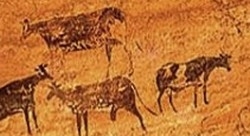
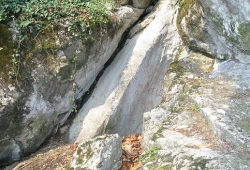

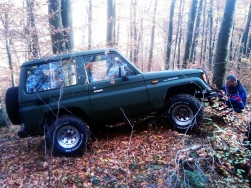
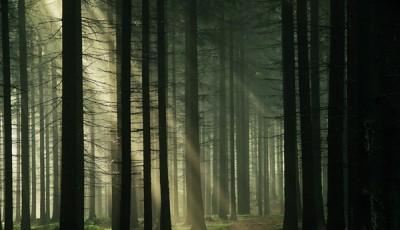
Rapa Rosie este o rezervatie geologica ai carei pereti ating inaltimi de pana la 100 de metri. Turistii sunt atrasi in primul rand de formele deosebite sapate de ape in lutul colinei.
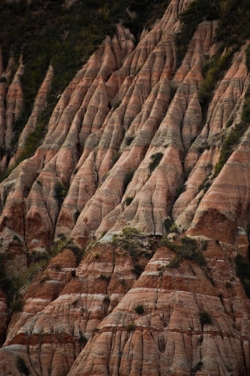
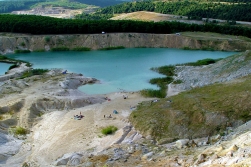
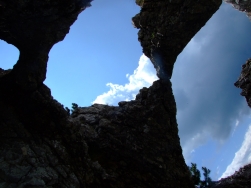
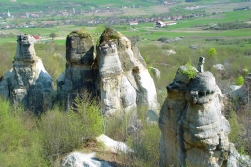
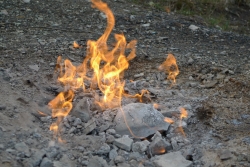
In urma cu doar 80 de ani, locul nu era marcat decat printr-o mica vaiuga.Aflata la o altitudine de peste 1.300 de metri, Groapa Ruginoasa s-a format din cauza eroziunii solului intr-un timp foarte scurt. Procesul de eroziune a scos la suprafata straturi de coartite. Culoarea rosie-violacee transforma zona intr-una deosebita, de la departare semanand cu o rana deschisa in trupul muntelui.Aspectul sau fantastic care sugereaza un colt din Canionul Colorado este astazi un adevarat laborator morfologic.
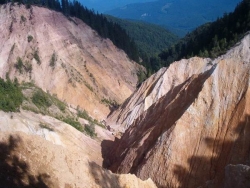
Balta vrajitoarelor
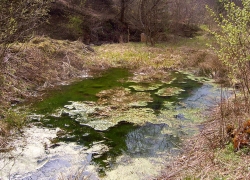
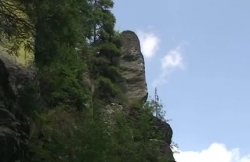
Filmul poate fi vizionat AICI
Sursa: Daniel Roxin
Two doctors from Bacau invented a machine that saves crushed bones. With their invention, Romania opened the most important external bone fixation congress in Barcelona. The device invented by Dr. Filipescu saves crushed bones without a scalpel, without screws or metal rods, according to Jurnalul National.
Until now, Dr. Filipescu and Dr. Popa had 76 cases in which they used the fixator. “Severe cases, people run over by train, car accidents and they come with their legs destroyed, you’ll be terrified if you look at the photos,” Dr. Popa recalls. After the device is fixed, in about 20 minutes, the leg is restored into position with the help of the Roenghen, which allows full view of leg fractures.
Nicolae Filipescu and Dan Popa explained that their device is used only on skin and bone and requires only one anesthetic, being a more cost effective option and limiting patients’ suffering.
The two doctors constantly improved the fixator. They noticed that it could be used not only on an open fracture but also on an inside fracture of high energy or big circulatory problems.
The device is currently used only to the benefit of Bacau County Hospital patients. “We cannot sell it. In Romania there are no producers of such medical equipment. The 15 devices we have in the hospital are made with our own personal incomes, without any help,” Filipescu said.
“Last year, we went to the international Barcelona congress,” Filipescu adds. “It was a real show of strength… When I saw Romania’s flag near the projector that was showing images of our interventions I felt so proud. Over the years, I received many job offers abroad. But I could never leave. Because I love seeing the Romanian flag applauded in a foreign country.”
Doi medici romani au inventat un aparat unic în lume care salvează oasele fărâmiţate
Doi medici din Bacău au inventat o maşinărie care salvează oasele fărâmiţate. Cu invenţia lor România a deschis, la Barcelona, cel mai important congres de fixare externă. Aparatul inventat de medicul Filipescu salvează oasele fărâmiţate fără bisturiu, fără şuruburi sau tije metalice, scrie Jurnalul National.
Până acum, doctorul Filipescu împreună cu doctorul Popa au avut 76 de cazuri în care au folosit fixatorul. “Cazuri grele, oameni călcaţi de tren, accident de maşină, care vin cu picioarele distruse, dacă vedeţi pozele făcute, vă îngroziţi”, rememorează doctorul Popa pacienţii trataţi. După ce aparatul este fixat, cam în 20 de minute, piciorul este pus în poziţia dorită cu ajutorul aparatului Roenghen, care permite vizualizarea completă a fracturilor piciorului.
“Noi, prin mişcările pe care le facem cu ajutorul coloanelor de ghidare, aducem osul în poziţia corectă. Cele patru semicercuri sunt fixate două în partea de sus, sub genunchi, şi în partea de jos a piciorului prin nişte broşe, un fel de andrele cu diametrul de 3 mm, ele fiind singura invazie în picior. Rezistă până la 500 de kilograme forţă. Ancorarea dispozitivului se face milimetric, matematic, din această cauză riscul de a întâlni vase de sânge, muşchi sau nervi este exclus. Practic, noi lucrăm numai în aşa numita zonă verde, unde nu sunt vase de sânge, ci numai piele şi os. Asta este şi una dintre diferenţele majore faţă de zecile de modele de fixatoare existente pe piaţă”, explică întregul mecanism de funcţionare a aparatului doctorul Neculai Filipescu, inventatorul maşinăriei.
“Fixatorul obişnuit este folosit la început, este doar o parte a tratamentului. O chestiune provizorie, până se liniştesc marile tulburări care apar. După aceea, se suspendă această fixare şi se continuă cu una internă, cu o nouă anestezie, operaţie, tijă, şuruburi etc. În cazul dispozitivului nostru, nu este nevoie decât de o anestezie, atunci când se fixează broşele. La suspendarea lui nu este nevoie de anestezie, se poate face într-un cabinet de ambulatoriu, fără internare. Aici putem vorbi şi despre limitarea costurilor, dincolo de suferinţa minimă a pacientului”, completează doctorul Dan Popa, partenerul de lucru şi de cercetare al doctorului Filipescu.
Un mare plus însă îl constituie şi faptul că fixatoarele care sunt pe piaţă acum nu pot să rezolve o fractură deschisă la nivelul tibiei decât folosind mai multe dispozitive de acest gen. “În cazul fixatorului nostru, extern universal minim invaziv, indiferent unde este focarul, că e sus la platou, că e la nivelul diafizei, se foloseşte doar el”, arată unicitatea aparatului doctorul Popa.
Cei doi medici au îmbunătăţit în permanenţă fixatorul. Din practică, au constatat că aparatul poate fi folosit nu numai pe fractură deschisă, cum sunt folosite toate celelalte, ci şi pe fractură închisă de înaltă energie (radiografia arată că “piciorul este făcut ţăndări”) sau tulburări circulatorii mari (pielea este plină cu băşici cu sânge sau cu ser). ” Pacientul se vindecă în câteva zile şi pleacă acasă. Într-un mod spectaculos se reduc tulburările, pentru că focarul este fixat. Necesitatea de a fi folosit şi la fracturi închise a apărut mai ales din cauza complicaţiile care urmau la intervenţiile clasice: deschizi rana, pui fragmentele cap la cap, tot felul de şuruburi, de plăci care duceau la complicaţii dramatice”, explică doctorul Popa.
Acum, de aparat beneficiază, din păcate, doar pacienţii Spitalului Judeţean din Bacău. Motivul? “Nu putem să-l comercializăm. În România nu există producător de astfel de aparatură medicală. Cele 15 aparate pe care le avem în spital sunt făcute efectiv din venituri personale, fără nici un ajutor”, enumeră doctorul Filipescu greutăţile întâmpinate.
Profesorul Filipescu caută astăzi firme care să-l ajute să găsească producători străini dornici să producă aparatul. ” Acest aparat poate fi folosit la nesfârşit, nu este consumabil. Doar broşele trebuie schimbate, în rest, nimic. “, spune doctorul Popa.
“Am fost anul trecut la Congresul internaţional de la Barcelona”, povesteşte doctorul Filipescu. “A fost o adevărată desfăşurare de forţe… Când am văzut steagul României în colţul proiectorului pe care se derulau imaginile din timpul intervenţiilor pe care noi le-am realizat pe pacienţi, mi-a crescut inima în piept. Am primit de-a lungul timpului oferte de muncă în străinătate. Dar nu aş putea să plec. Pentru că iubesc să văd steagul României arborat pe un colţ de perete şi aplaudat într-o ţară străină.”
Sursa: http://bucharestherald.com

